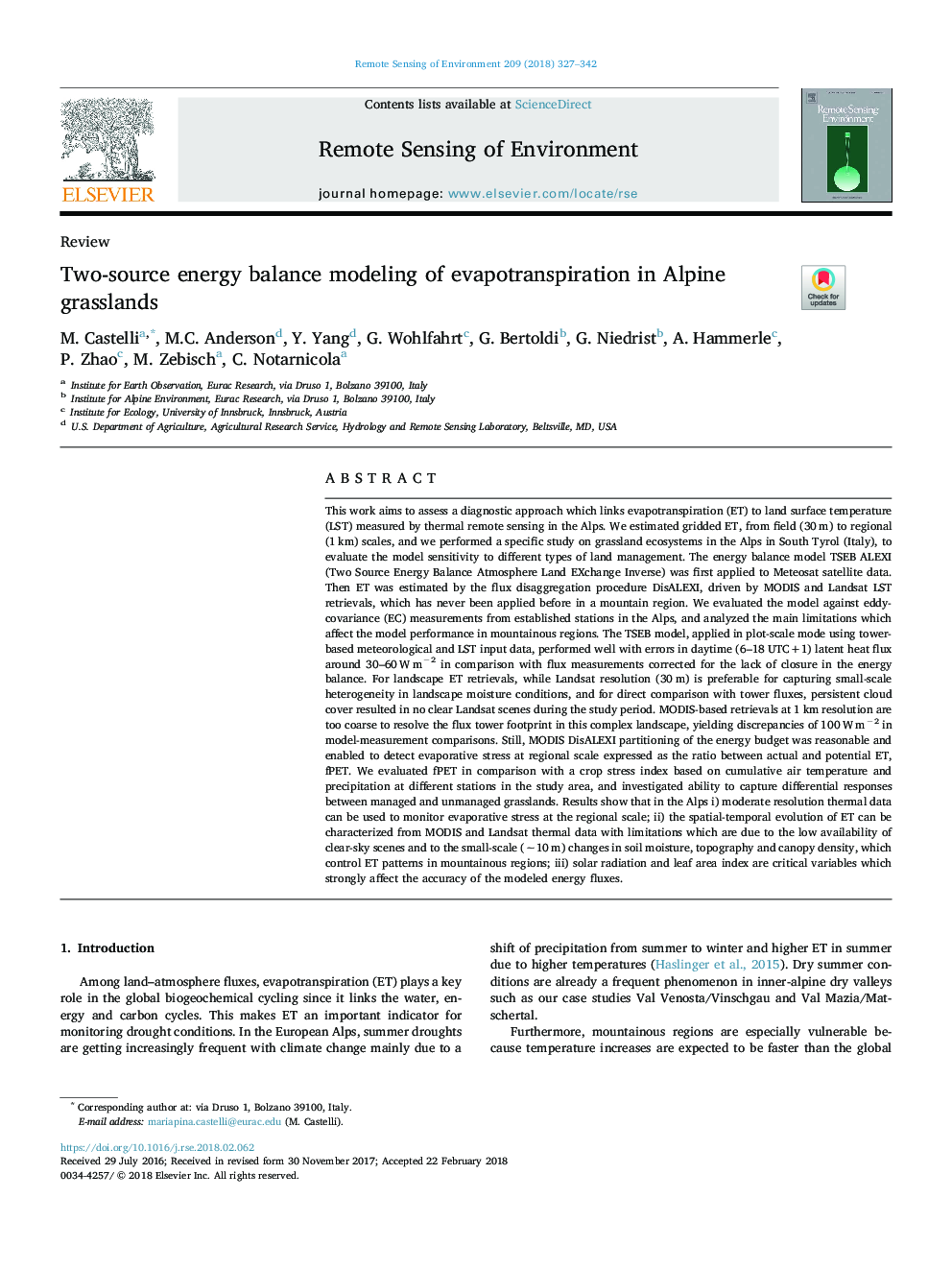| کد مقاله | کد نشریه | سال انتشار | مقاله انگلیسی | نسخه تمام متن |
|---|---|---|---|---|
| 8866643 | 1621191 | 2018 | 16 صفحه PDF | دانلود رایگان |
عنوان انگلیسی مقاله ISI
Two-source energy balance modeling of evapotranspiration in Alpine grasslands
ترجمه فارسی عنوان
مدل سازی تعادل انرژی دو جانبه تبخیر زدایی در مراتع آلپ
دانلود مقاله + سفارش ترجمه
دانلود مقاله ISI انگلیسی
رایگان برای ایرانیان
موضوعات مرتبط
مهندسی و علوم پایه
علوم زمین و سیارات
کامپیوتر در علوم زمین
چکیده انگلیسی
This work aims to assess a diagnostic approach which links evapotranspiration (ET) to land surface temperature (LST) measured by thermal remote sensing in the Alps. We estimated gridded ET, from field (30â¯m) to regional (1â¯km) scales, and we performed a specific study on grassland ecosystems in the Alps in South Tyrol (Italy), to evaluate the model sensitivity to different types of land management. The energy balance model TSEB ALEXI (Two Source Energy Balance Atmosphere Land EXchange Inverse) was first applied to Meteosat satellite data. Then ET was estimated by the flux disaggregation procedure DisALEXI, driven by MODIS and Landsat LST retrievals, which has never been applied before in a mountain region. We evaluated the model against eddy-covariance (EC) measurements from established stations in the Alps, and analyzed the main limitations which affect the model performance in mountainous regions. The TSEB model, applied in plot-scale mode using tower-based meteorological and LST input data, performed well with errors in daytime (6-18â¯UTC+1) latent heat flux around 30-60â¯Wâ¯mâ2 in comparison with flux measurements corrected for the lack of closure in the energy balance. For landscape ET retrievals, while Landsat resolution (30â¯m) is preferable for capturing small-scale heterogeneity in landscape moisture conditions, and for direct comparison with tower fluxes, persistent cloud cover resulted in no clear Landsat scenes during the study period. MODIS-based retrievals at 1â¯km resolution are too coarse to resolve the flux tower footprint in this complex landscape, yielding discrepancies of 100â¯Wâ¯mâ2 in model-measurement comparisons. Still, MODIS DisALEXI partitioning of the energy budget was reasonable and enabled to detect evaporative stress at regional scale expressed as the ratio between actual and potential ET, fPET. We evaluated fPET in comparison with a crop stress index based on cumulative air temperature and precipitation at different stations in the study area, and investigated ability to capture differential responses between managed and unmanaged grasslands. Results show that in the Alps i) moderate resolution thermal data can be used to monitor evaporative stress at the regional scale; ii) the spatial-temporal evolution of ET can be characterized from MODIS and Landsat thermal data with limitations which are due to the low availability of clear-sky scenes and to the small-scale (â¼10â¯m) changes in soil moisture, topography and canopy density, which control ET patterns in mountainous regions; iii) solar radiation and leaf area index are critical variables which strongly affect the accuracy of the modeled energy fluxes.
ناشر
Database: Elsevier - ScienceDirect (ساینس دایرکت)
Journal: Remote Sensing of Environment - Volume 209, May 2018, Pages 327-342
Journal: Remote Sensing of Environment - Volume 209, May 2018, Pages 327-342
نویسندگان
M. Castelli, M.C. Anderson, Y. Yang, G. Wohlfahrt, G. Bertoldi, G. Niedrist, A. Hammerle, P. Zhao, M. Zebisch, C. Notarnicola,
